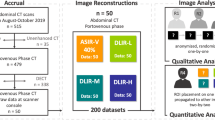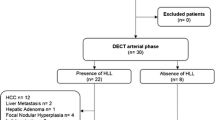Abstract
Purpose
Adaptive statistical iterative reconstruction (ASIR) is a reconstruction technique for computed tomography (CT) that reduces image noise. The purpose of our study was to investigate whether ASIR improves the quality of volume-rendered (VR) CT portovenography.
Materials and methods
Institutional review board approval, with waived consent, was obtained. A total of 19 patients (12 men, 7 women; mean age 69.0 years; range 25–82 years) suspected of having liver lesions underwent three-phase enhanced CT. VR image sets were prepared with both the conventional method and ASIR. The required time to make VR images was recorded. Two radiologists performed independent qualitative evaluations of the image sets. The Wilcoxon signed-rank test was used for statistical analysis. Contrast-noise ratios (CNRs) of the portal and hepatic vein were also evaluated.
Results
Overall image quality was significantly improved by ASIR (P < 0.0001 and P = 0.0155 for each radiologist). ASIR enhanced CNRs of the portal and hepatic vein significantly (P < 0.0001). The time required to create VR images was significantly shorter with ASIR (84.7 vs. 117.1 s; P = 0.014).
Conclusion
ASIR enhances CNRs and improves image quality in VR CT portovenography. It also shortens the time required to create liver VR CT portovenographs.
Similar content being viewed by others
References
Lee SS, Kim TK, Byun JH, Ha HK, Kim PN, Kim AY, et al. Hepatic arteries in potential donors for living related liver transplantation: evaluation with multi-detector row CT angiography. Radiology 2003;227:391–399.
Kang HK, Jeong YY, Choi JH, Choi S, Chung TW, Seo JJ, et al. Three-dimensional multi-detector row CT portal venography in the evaluation of portosystemic collateral vessels in liver cirrhosis. Radiographics 2002;22:1053–1061.
Guiney MJ, Kruskal JB, Sosna J, Hanto DW, Goldberg SN, Raptopoulos V. Multi-detector row CT of relevant vascular anatomy of the surgical plane in split-liver transplantation. Radiology 2003;229:401–407.
Sahani D, Mehta A, Blake M, Prasad S, Harris G, Saini S. Preoperative hepatic vascular evaluation with CT and MR angiography: implications for surgery. Radiographics 2004;24:1367–1380.
Radtke A, Nadalin S, Sotiropoulos GC, Molmenti EP, Schroeder T, Valentin-Gamazo C, et al. Computer-assisted operative planning in adult living donor liver transplantation: a new way to resolve the dilemma of the middle hepatic vein. World J Surg 2007;31:175–185.
Papke K, Kuhl CK, Fruth M, Haupt C, Schlunz-Hendann M, Sauner D, et al. Intracranial aneurysms: role of multidetector CT angiography in diagnosis and endovascular therapy planning. Radiology 2007;244:532–540.
Villablanca JP, Rodriguez FJ, Stockman T, Dahliwal S, Omura M, Hazany S, et al. MDCT angiography for detection and quantification of small intracranial arteries: comparison with conventional catheter angiography. AJR Am J Roentgenol 2007;188:593–602.
Saba L, Caddeo G, Sanfilippo R, Montisci R, Mallarini G. Efficacy and sensitivity of axial scans and different reconstruction methods in the study of the ulcerated carotid plaque using multidetector-row CT angiography: comparison with surgical results. AJNR Am J Neuroradiol 2007;28:716–723.
Vanhoenacker PK, Heijenbrok-Kal MH, Van Heste R, Decramer I, Van Hoe LR, Wijns W, et al. Diagnostic performance of multidetector CT angiography for assessment of coronary artery disease: meta-analysis. Radiology 2007;244:419–428.
Das KM, El-Menyar AA, Salam AM, Singh R, Dabdoob WAK, Albinali HA, et al. Contrast-enhanced 64-section coronary multidetector CT angiography versus conventional coronary angiography for stent assessment. Radiology 2007;245:424–432.
Duong PA, Ferson PF, Fuhrman CR, McCurry KR, Lacomis JM. 3D-multidetector CT angiography in the evaluation of potential donors for living donor lung transplantation. J Thorac Imaging 2005;20:17–23.
Lawler LP, Fishman EK. Multi-detector row CT of thoracic disease with emphasis on 3D volume rendering and CT angiography. Radiographics 2001;21:1257–1273.
Willmann JK, Baumert B, Schertler T, Wildermuth S, Pfammatter T, Verdun FR, et al. Aortoiliac and lower extremity arteries assessed with 16-detector row CT angiography: prospective comparison with digital subtraction angiography. Radiology 2005;236:1083–1093.
Imamura HH. Anatomical keys and pitfalls in living donor liver transplantation. J Hepatobiliary Pancreat 2000;7:380–394.
Onodera Y, Omatsu T, Nakayama J, Kamiyama T, Furukawa H, Todo S, et al. Peripheral anatomic evaluation using 3D CT hepatic venography in donors: significance of peripheral venous visualization in living-donor liver transplantation. AJR Am J Roentgenol 2004;183:1065–1070.
Calhoun PS, Kuszyk BS, Heath DG, Carley JC, Fishman EK. Three-dimensional volume rendering of spiral CT data: theory and method. Radiographics 1999;19:745–764.
Thibault JB, Sauer KD, Bouman CA, Hsieh J. A threedimensional statistical approach to improved image quality for multislice helical CT. Med Phys 2007;34:4526–4544.
Marin D, Nelson RC, Schindera ST, Richard S, Youngblood RS, Yoshizumi TT, et al. Low-tube-voltage, high-tube-current multidetector abdominal CT: improved image quality and decreased radiation dose with adaptive statistical iterative reconstruction algorithm—initial clinical experience. Radiology 2010;254:145–153.
Hara AK, Paden RG, Silva AC, Kujak JL, Lawder HJ, Pavlicek W. Iterative reconstruction technique for reducing body radiation dose at CT: feasibility study. AJR Am J Roentgenol 2009;193:764–771.
Silva AC, Lawder HJ, Hara A, Kujak J, Pavlicek W. Innovations in CT dose reduction strategy: application of the adaptive statistical iterative reconstruction algorithm. AJR Am J Roentgenol 2010;194:191–199.
Shin H, Falck C, Galanski M. Low-contrast detectability in volume rendering: a phantom study on multidector-row spiral CT data. Eur Radiol 2004;14:341–349.
Pelc JS, Beaulieu CF. Volume rendering of tendon-bone relationships using unenhanced CT. AJR Am J Roentgenol 2001;176:973–977.
Samei E, Dobbins JT 3rd, Lo JY, Tornai MP. A framework for optimising the radiographic technique in digital X-ray imaging. Radiat Prot Dosimetry 2005;114:220–229.
Hwang GJ, Kim MJ, Yoo HS, Lee JT. Nodular hepatocellular carcinomas: detection with arterial-, portal-, and delayedphase images at spiral CT. Radiology 1997;202:383–388.
Monzawa S, Ichikawa T, Nakajima H, Kitanaka Y, Omata K, Araki T. Dynamic CT for detecting small hepatocellular carcinoma: usefulness of delayed phase imaging. AJR Am J Roentgenol 2007;188:147–153.
Kim T, Murakami T, Takahashi S, Tsuda K, Tomoda K, Narumi Y, et al. Optimal phase of dynamic CT for detecting hepatocellular carcinoma: evaluation of unenhanced and triple-phase images. Abdom Imaging 1999;24:473–480.
Tsurusaki M, Sugimoto K, Fujii M, Sugimura K. Multidetector row helical CT of the liver: quantitative assessment of iodine concentration of intravenous contrast material on multiphasic CT: a prospective randomized study. Radiat Med 2004;22:239–245.
Author information
Authors and Affiliations
Corresponding author
About this article
Cite this article
Matsuda, I., Hanaoka, S., Akahane, M. et al. Adaptive statistical iterative reconstruction for volume-rendered computed tomography portovenography: improvement of image quality. Jpn J Radiol 28, 700–706 (2010). https://doi.org/10.1007/s11604-010-0490-5
Received:
Accepted:
Published:
Issue Date:
DOI: https://doi.org/10.1007/s11604-010-0490-5




